Biology Final: unit 3
5.0(1)
Card Sorting
1/65
Study Analytics
Name | Mastery | Learn | Test | Matching | Spaced |
|---|
No study sessions yet.
66 Terms
1
New cards
How is parasitism different from commensalism?
One organism is harmed in parasitism and no organisms are harmed in commensalism.
2
New cards
What is the difference between primary and secondary succession?
secondary succession begins on soil and primary succession begins on newly exposed surfaces
3
New cards
What is one difference between primary and secondary succession?
Secondary succession begins on soil and primary succession begins on newly exposed surfaces.
4
New cards
Each of the following is an abiotic factor in the environment EXCEPT
plant life
5
New cards
An ecologist who is studying a group of ecosystems that have similar climates and are home to similar organisms is studying a __community__.
false
6
New cards
A bird stalks, kills, and then eats an insect. Based on its behavior, which pair of ecological terms describes the bird?
carnivore, heterotroph
7
New cards
Matter can recycle through the biosphere because
biological systems do not use up matter, they transform it.
8
New cards

Refer to the illustration above. Level “A” is composed of
producers
9
New cards
Which is an example of how biotic and abiotic factors interact?
. Tree roots split apart rocks in the ground
10
New cards
The branch of biology dealing with interactions among organisms and between organisms and their environment is called
ecology
11
New cards
A symbiotic relationship in which one organism is harmed and the other benefits is
parasitism
12
New cards
Which is a factor that could interrupt the progress of succession?
another natural disturbance
13
New cards
Which statement describes how humans are affecting the balance of carbon in the atmosphere?
Burning fossil fuels in great quantities has increased the amount of carbon dioxide in the atmosphere.
14
New cards
Which of the following occurs during the ecological succession of an ecosystem?
. Living organisms modify their environment a little at a time.
15
New cards
Which interaction would benefit only one organisms in a relationship?
commensalism
16
New cards
The number of trophic levels in an ecological pyramid
is limited by the amount of energy that is lost at each trophic level.
17
New cards
When an exotic species overwhelms a native species it becomes
an invasive species
18
New cards
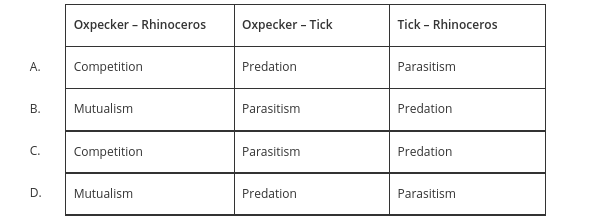
Oxpeckers (tickbirds) are small birds that feed on ticks which infest large animals like rhinoceros.
What are the relationships between these species?
What are the relationships between these species?
D
19
New cards
Bacteria in our gut help us break down food and some make nutrients we absorb. The bacteria in return are given a safe environment and a steady supply of food. This relationship is an example of
mutualism
20
New cards
A wolf pack hunts, kills, and feeds on a moose. In this interaction, the wolves are
predators
21
New cards
Only 10 percent of the energy stored in an organism can be passed on to the next trophic level. Of the remaining energy, some is used for the organism’s life processes, and the rest is
eeliminated as heat
22
New cards
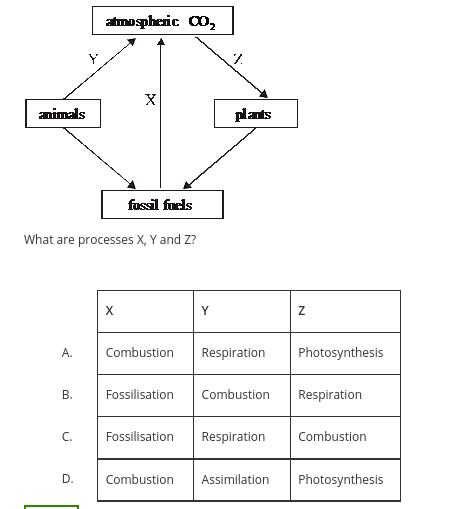
The figure below shows a simplified model of the carbon cycle. Each arrow represents a process which involves a transfer of carbon.
A
23
New cards
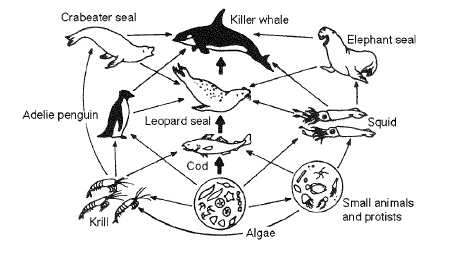
Refer to the illustration above. Killer whales feed at the
. third and fourth trophic levels.
24
New cards
A group of organisms of different species living together in a particular place is called
a community
25
New cards
In ecosystems the amount of energy that passes from one trophic level to the next is called the conversion efficiency. What is the average conversion efficiency from primary to secondary consumers in most ecosystems?
10%
26
New cards
Which of the following does *not* contain carbon from the bodies of plants and animals that died millions of years ago?
phosphate salts
27
New cards
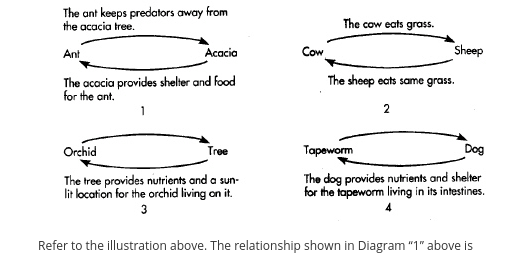
The diagrams below show different kinds of interactions between species.
mutalism
28
New cards
Suppose that a species of toads is introduced into a new environment in an attempt to reduce the population of insects. The toad has no natural predators in the new environment. The toad population would most likely
icrease exponentially
29
New cards
Which of the following has a direct role in the nitrogen cycle?
all fo the above
30
New cards
The lowest level of environmental complexity that includes living and nonliving factors is the
ecosysetm
31
New cards
What are the main processes by which carbon is released in the atmosphere?
a. Cellular respiration of consumers, producers and combustion of fossil fuels
32
New cards
Which of the following ecological units includes abiotic factors?
an ecostem
33
New cards
All the interconnected feeding relationships in an ecosystem make up a food
web
34
New cards
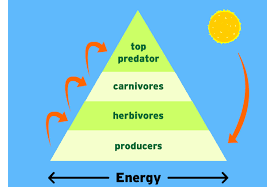
What is the term for each step in the transfer of energy and matter within a food web?
trophic level
35
New cards

Which of the following is a food chain in the food web shown
grass, grasshopper, snake, hawk
36
New cards
What is the term for each step in the transfer of energy and matter within a food web?
trophic level
37
New cards
Carbon cycles through the biosphere in all of the following processes EXCEPT
transpiration
38
New cards
Which is a biotic factor that affects the size of a population in a specific ecosystem?
a. number and kinds of predators in the ecosystem
39
New cards
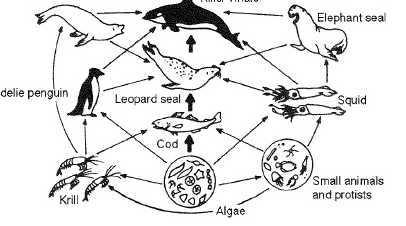
Refer to the illustration above. Leopard seals are
carnivores
40
New cards
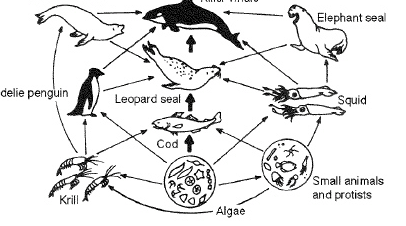
Refer to the illustration above. The photosynthetic algae are
producers
41
New cards
What term refers to a community and its abiotic environment?
ecosyetm
42
New cards
As part of the carbon cycle, carbon can be found in all of the following *except*:
* \
* \
None of the above, all are sources of carbon for the carbon cycle.
43
New cards
refer to the illustration above. The relationship shown in Diagram “4” above is
parasitism
44
New cards
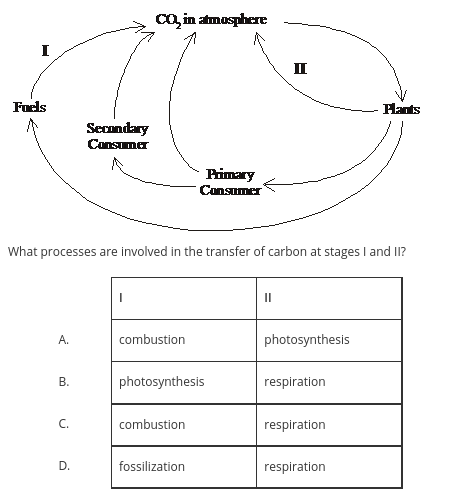
The diagram below shows a simplified version of the carbon cycle.
\
\
c
45
New cards
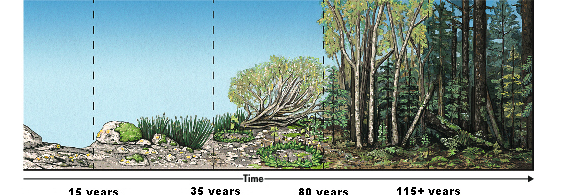
Figure 4–2 shows succession in an ecosystem. What organisms are found in the climax community for this ecosystem?
trees and shrubs
46
New cards
Primary succession would most likely occur after
a lava flow
47
New cards
Which of the following descriptions about the organization of an ecosystem is correct?
Species make up populations, which make up communities.
48
New cards
Which of the following examples describes the relationship between organisms, populations, communities, ecosystems and the biosphere?
Similar organisms form populations, different populations become communities, communities with abiotic \n factors become an ecosystem and many ecosystems make up the biosphere
49
New cards
In a four-level energy pyramid, if the first level contains 5000 calories of energy, the third level will have approximately _ calories.
50
50
New cards
Carbon is a major component of all organic compounds, including carbohydrates, lipids, proteins, and nucleic acids. Carbon dioxide is continually exchanged between the atmosphere and oceans. What **geological** process most likely returns carbon to the atmosphere in the form of carbon dioxide?
volcanic activity
51
New cards
The repeated movement of water between Earth’s surface and the atmosphere is called
the water cycle
52
New cards
Which of the following series correctly represents the hierarchical organization within ecology?
population ® community ® ecosystem ® biosphere
53
New cards
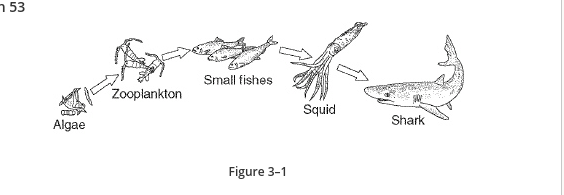
The algae at the beginning of the food chain in Figure 3–1 are
primary producers
54
New cards
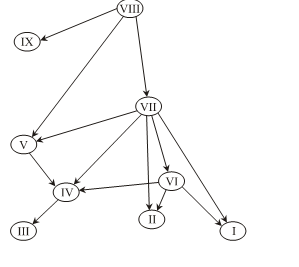
Which of the species feed both as secondary consumers and as tertiary consumers?
I, II and IV only
55
New cards
Corn planted in a field that has been previously planted with legumes and then plowed under is likely to be
more productive because bacteria living on the roots of legumes fix nitrogen in the soil.
56
New cards
The simplest grouping of more than one kind of organism in the biosphere is
a community
57
New cards
A symbiotic relationship in which both species benefit is
mutualsim
58
New cards
59
New cards
A group of plants or animals that are alike and that can produce offspring under natural conditions is called a
population
60
New cards

Refer to the illustration above. The relationship shown in Diagram “2” above is
competition
61
New cards
What is at the base of all ecological pyramids?
producers
62
New cards
The movements of energy and nutrients through living systems are different because
energy flows in one direction, and nutrients recycle.
63
New cards
To date, humans have interfered with all of the biogeochemical cycles on Earth, but this interference has been of the greatest magnitude, in terms of human-induced changes in climate, in the:
carbon cycle
64
New cards
\n Nitrogen fixation is carried out primarily by
bacteria
65
New cards
What percent of the energy stored in an organism can be passed on to the next trophic level?
10%
66
New cards
Communities are composed of:
* \
* \
all of the populations of all the different species that live together within an area.